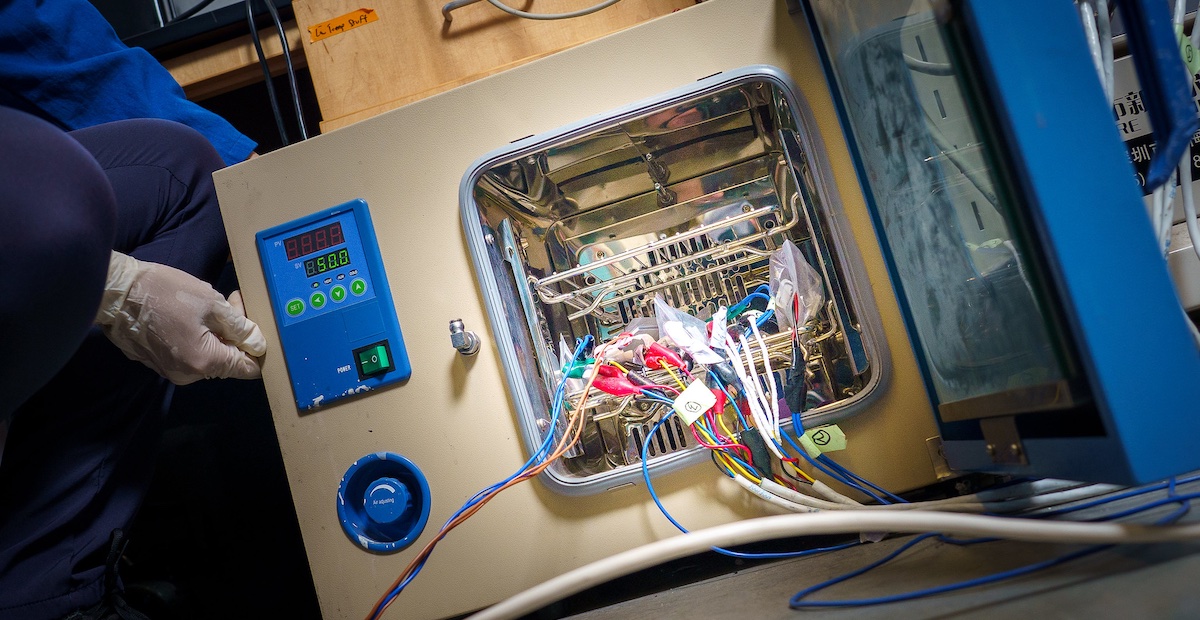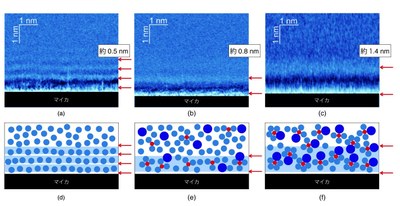新しい電解質設計は、鉱業や宇宙開発などにも応用できるかもしれない A new electrolyte design may have applications in mining, space exploration and more
2022-12-21 カリフォルニア大学サンディエゴ校(UCSD)
 Engineers at the University of California San Diego have developed lithium-ion batteries that perform well at freezing cold and scorching hot temperatures. Photos by David Baillot/UC San Diego Jacobs School of Engineering.
Engineers at the University of California San Diego have developed lithium-ion batteries that perform well at freezing cold and scorching hot temperatures. Photos by David Baillot/UC San Diego Jacobs School of Engineering.
カリフォルニア大学サンディエゴ校のジェイコブス工学部の教授で、論文の共著者であるZheng Chen氏は、「基本的には、深海や宇宙だけでなく、米国のどの州でも電池を使用できるようになります」と述べています。”アリゾナでセルが簡単に火事になったり、ウィスコンシンで凍結したりする心配がなくなります。”
この研究は、チェン教授のグループと、シカゴ大学分子工学教授でカリフォルニア大学サンディエゴ校ナノ工学の非常勤教授であるY・シャーリー・メンが率いるグループとの研究チームによって行われました。Advanced Materials』2022年10月25日号に掲載された論文で深く掘り下げられている。
今回開発した電池は、ジブチルエーテルとリチウム塩を混合した液からなる新しい電解質により、超高温・低温下でも優れた性能を発揮する。ジブチルエーテルは沸点が141℃と高く、灼熱の中でも液体を保つことができる。また、ジブチルエーテル分子はリチウムイオンと弱く結合し、この弱い分子間相互作用が極限温度での性能を向上させる。この弱い分子間相互作用が、氷点下での電池性能を向上させることを、研究者らは以前の研究で発見していた。
研究チームは、透過型電子顕微鏡による特性評価を統合した体系的なX線光電子分光法を用いて、CFxの低温性能の界面を評価した。電解質の高速輸送とアニオンペアリング溶媒和構造が低温での電荷移動抵抗を低減し、Li/CFx電池の性能(活物質ベースで1690 Wh kg-1、-60℃)を向上させることに成功した。50 mg cm-2の負荷電極を使用した場合、Li/CFxは-60℃で1530 Wh kg-1を示したままである。
<関連情報>
- https://today.ucsd.edu/story/scientists-at-uc-san-diego-introduce-a-battery-for-extreme-temperatures
- https://onlinelibrary.wiley.com/doi/abs/10.1002/adma.202207932
高速輸送とアニオンペアリングが可能な液化ガス電解質による超低温Li/CFx電池の開発 Ultralow-Temperature Li/CFx Batteries Enabled by Fast-Transport and Anion-Pairing Liquefied Gas Electrolytes
Yijie Yin, John Holoubek, Alex Liu, Baharak Sayahpour, Ganesh Raghavendran, Guorui Cai, Bing Han, Matthew Mayer, Noah B. Schorr, Timothy N. Lambert, Katharine L. Harrison, Weikang Li, Zheng Chen, Y. Shirley Meng
Advanced Materials Published: 25 October 2022
DOI:https://doi.org/10.1002/adma.202207932
Abstract
Lithium fluorinated-carbon (Li/CFx) is one of the most promising chemistries for high-energy-density primary energy-storage systems in applications where rechargeability is not required. Though Li/CFx demonstrates high energy density (>2100 Wh kg−1) under ambient conditions, achieving such a high energy density when exposed to subzero temperatures remains a challenge, particularly under high current density. Here, a liquefied gas electrolyte with an anion-pair solvation structure based on dimethyl ether with a low melting point (−141 °C) and low viscosity (0.12 mPa s, 20 °C), leading to high ionic conductivity (>3.5 mS cm−1) between −70 and 60 °C is reported. Besides that, through systematic X-ray photoelectron spectroscopy integrated with transmission electron microscopy characterizations, the interface of CFx is evaluated for low-temperature performance. The fast transport and anion-pairing solvation structure of the electrolyte are concluded to bring about reduced charge-transfer resistance at low temperatures, which results in significantly enhanced performance of Li/CFx cells (1690 Wh kg−1, −60 °C based on active materials). Utilizing 50 mg cm−2 loading electrodes, the Li/CFx still displays 1530 Wh kg−1 at −60 °C. This work provides insights into the electrolyte design that may overcome the operational limits of batteries in extreme environments.



